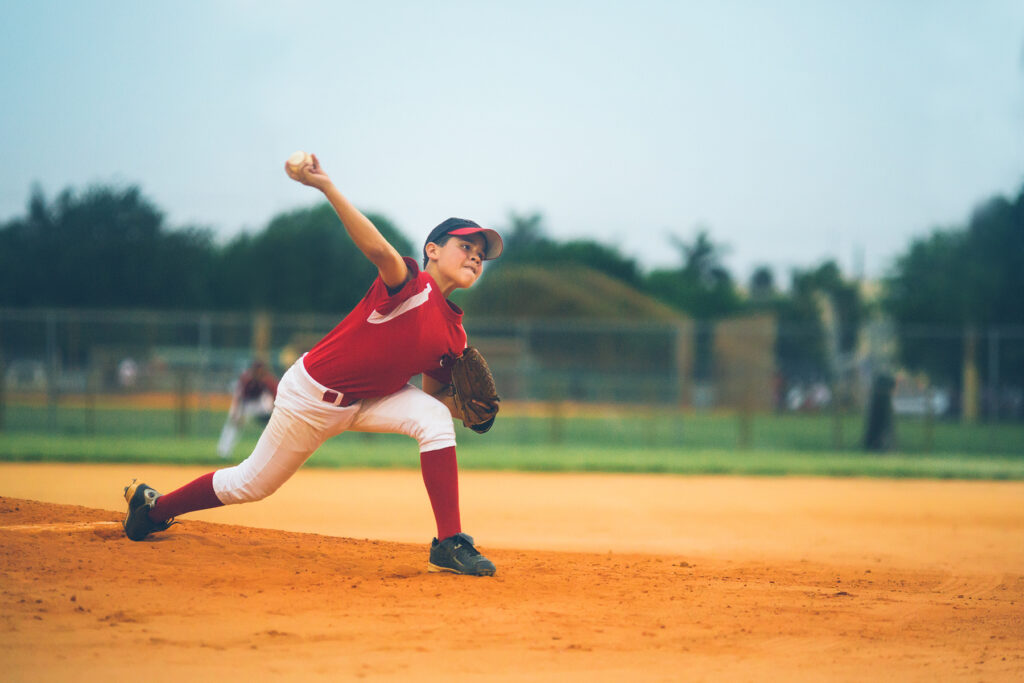Shoulder injuries in children are caused differently, depending on the child’s age and activity level. In general, we see pediatric shoulder injuries from overuse while playing sports that involve the upper extremities. Baseball, softball, swimming, and tennis are the most common, with boys suffering sports-related shoulder injuries more frequently than girls due to the nature of the sport. We see Little League pitchers as young as 9 in our pediatric orthopedic practice.
Traumatic events that can lead to a shoulder injury are usually falls that cause bruising and sprains; dislocation is another result of a serious fall or other accident and are frequently seen among teenagers.
Pediatric Shoulder injury diagnosis and treatment
Outside of a traumatic event that brings kids into our office or the ER right away, parents should be aware of two warning signs that suggest they should see a doctor for their child’s shoulder injury are:
1 – The pain is worse with activity even after a few days of rest
2 – A gross deformity is present, with the shoulder asymmetrical to the other side
At The Pediatric Orthopedic Center, we take a thorough history and perform a physical examination; sometimes an X-ray is needed to confirm or rule out a diagnosis. The treatment of a child’s shoulder injury depends on the diagnosis:
- Overuse injuries – we recommend the child rest for a period ranging from several days to one-to-two weeks, icing the shoulder and anti-inflammatory medications. The most important thing is to understand the underlying cause of the injury; it could stem from too much activity without rest, improper athletic technique, or underlying musculoskeletal weakness.
- While rest and inflammation control are essential to heal overuse injuries, physical therapy (PT) may be prescribed to promote full rehabilitation and to strengthen the shoulder to prevent future shoulder pain injury. Most athletes can get back to their previous level of activity following a prescribed course of rest, medication, and PT.
- Dislocations – shoulder dislocations are diagnosed through X-ray. We perform what’s called a “reduction” to repair the dislocation in the office (the orthopedist on call in the ER can also perform this at the hospital).
- More severe injuries, such as a fracture – we immobilize the shoulder with an immobilizer (a sling with an extra strap) and refer the patient for advanced imaging such as an MRI to ascertain the full extent of the shoulder injury.
- If the MRI confirms the injury is inside the joint, we may recommend arthroscopic surgery to optimize recovery. Surgery is called for if the child or teenager suffers a labral tear or has “loose bodies” (bone or cartilage chips). Recovery is dependent on the extent of the injury and generally includes 6-12 weeks of rest and physical therapy, during which time the child will also wear a sling to minimize use and stabilize his or her shoulder.
- For clavicle fractures, primal humorous fractures, or acromioclavicular joint (AC) separation due to a fall while skiing or snowboarding, for example, we treat these with a full immobilizer and rest.
Best prevention methods for pediatric shoulder injuries
At The Pediatric Orthopedic Center, we advise parents that their children should avoid playing a single sport year-round until they reach high school age, when their growth plates have matured. This ensures they (and their joints) get adequate rest throughout the year.
Strength training and proper warm-up before starting any athletic activity is key to preventing injury. Equally important are a cool-down period following play, and scheduling at least one rest day a week in their athletic calendar.
If a student athlete notices pain with repetitive activity or if the pain is negatively impacting his or her sports performance, it is important to address this early on to prevent further injury.
For the coaches reading this, remember that children want to be team players and show up for the team even if they are experiencing pain. It is important to build a relationship of trust with student-athletes, so they are comfortable speaking up regarding any pain they are experiencing. Encourage children to also share other activities they’re engaged in, so you can be aware of the heightened potential for injury. The pediatric orthopedists at The Pediatric Orthopedic Center treat young athletes of all ages. Our orthopedic surgeons are all trained in the latest arthroscopic techniques and open shoulder procedures to repair shoulder injuries, other joint injuries, and bone fractures. Our treatment goal is to help kids heal as quickly and as completely as possible.
When to see a pediatric orthopedist
If your child is experiencing pain from regular sports activity or has been injured while playing, contact us to request an appointment in our Cedar Knolls, Springfield, or Wayne office.



